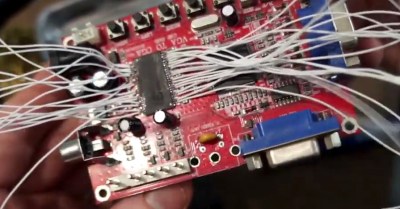If you’re interested in circuit bent video but not sure where to start, the excellent guide [LoFi Future] has come up with for modifying the cheap and readily available GBS-8100 VGA to composite converter would be a great first step. While we wouldn’t call it an easy modification, the circuit documentation and demonstration video below go a long way to making it as accessible as possible to new players.

While other video converters have all-in-one chipsets that are much harder to work with, [LoFi Future] explains that the separate EM636165TS DRAM chip on the GBS-8100 provides an ideal spot to tap in and wreak some technicolor havoc. By mapping out the pins and studying how the video output is corrupted by grounding them out or connecting them to each other, he’s been able to come up with fairly repeatable “recipes” for different effects.
In the most basic form, once you’ve soldered the pins of the DRAM chip up to the plug board interface, you’d technically be done. But [LoFi Future] takes it a step further and pairs the GBS-8100 with a separate composite to VGA converter. This provides some additional effects in the form of feedback loops and hue adjustment, but more practically, allows the device to handle composite on both the input and output. It’s a lot of hardware to cram into the enclosure, but thanks to little touches like the printed panel graphics, the final product does looks very professional.
Aside from the occasional modified NES Zapper, most of the circuit bent hardware we see is of the audio variety. But with projects like this one and the MIDI controlled SNES we covered last year as inspiration, we might see a balancing of the scales.
















Would be interesting to use this as some kind of music visualizer. Could probably even use a microcontroller to automate the glitches by grounding out the pins to the GPIO, so it could loop through preset routines.
Thanks for sharing. The amount of hacking seems a bit daunting though. If that chip could be desoldered and then have a socket put in place to plug in a board that would maybe require less work. But I guess making a new board altogether would be better. We definitely need more video glitch gear in the community.